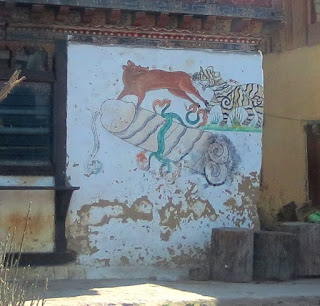Life in Bhutan has many quirks that
make everyday living odd and whimsical all the same. One of them that I
particularly enjoy is graffiti.
Graffiti often carries a negative
connotation in American culture due to certain iterations that express
obscenities just for the sake of being offensive or sexually suggestive
invitations that are often demeaning in nature. But in certain urban environments
graffiti has become an opportunity for artistic expression, satire, political
revolution, and inspiration.
Bhutan’s version of graffiti is
nowhere on this spectrum, but I assure you it is awesome. There are four types
of graffiti I have encountered thus far, which I will expand on below. While at
its heart these are innocuous (once you understand the background behind them),
if you are easily offended, perhaps it is best you steer clear.
Type 1: Mantras
Mantras
are Buddhist teachings chanted in repetition. Saying them is somewhat
equivalent to the spinning a prayer wheel (which themselves have mantras
written on them), circumambulating a chorten, or putting up prayer flags to
flap in the wind—these all generate good karma for oneself and for all sentient
beings, effectively lessening suffering in the world and compounding ‘spirit
points’ to ensure in your next life you will continue to be born a human and
with it, a better chance of achieving enlightenment and escaping the process of
rebirth.
The
exact meaning of individual mantras can be difficult to explain as their
explication may take hours or years to fully comprehend. But nevertheless they
are widely accepted expressions of complex texts through condensed,
easy-to-memorize phrases. And while you certainly can just say them, it seems
people enjoy writing them as well on random rocks, road sides, and sacred
religious sites. The one I most encounter, seeing as it’s the only one I can
actually read in Dzongkha, is the famous om mani peme hun. Here are a few
examples:
Type 2: @#$%!
Sure
this variety is all too conventional, but what this lacks in this case is
proper context. Swear words are an entirely different beast in Bhutan. They are
not used to insult, even in Dzongkha, though they may arise when expressing
frustration at a situation. Mean-spirited verbal projections have no place in
Bhutanese society because people tend to say what they think to each other’s
faces without it causing a problem. I’ve heard people tell others to their face
they don’t like their behavior, attitude, and work ethic, and yet they can
still share a laugh and spend hours together in close proximity without any
sign of discomfort. It’s awesomely weird. Lying and withholding complaints or
grudges are counterintuitive to a collective society and Bhutanese logic, and
after being in this environment, it makes me kind of question why we do it.
I’m
getting off track, though. My point is swearing is no big deal. It isn’t meant
to be rude and most of my students can’t even comprehend how the word ‘shit’
can be offensive. I’ve heard 9-year old girls say “oh shit” when they make a
mistake in their notebook. It’s hilarious. Admittedly I was shocked at first,
but I quickly learned it doesn’t carry the same weight here as it does to my
homeland and to reprimand them for my own cultural bias would be wrong (though
I did explain my culture’s perspective on the matter should they interact with
other foreigners).
So to
see these dreaded 4-letter words carved into rocks and painted on streets is
not so offensive after all. If anything it shows a kind of curiosity and
exploration—if not a naivety as to its true meaning and intent.
Type 3: The Phallus (NSFW)
Phallic
imagery is rife in Bhutan. Again it shocks, but like type 2, there is no cause
for alarm. You see, in the late 15th century a Tibetan lama by the
name of Drukpa Kunley came into Bhutan to spread the message of Buddhism, but
he did so in a most unconventional way; he used obscene humor, alcohol, and sex
to preach the dharma. This kind of teaching helped to loosen the hold of strict
Buddhist traditions and the hardcore ascetic route to enlightenment. And, well,
he really liked to use his “thunderbolt of flaming wisdom” (a euphemism he used
for a particular appendage if you catch my drift) as part and parcel of this
teaching. The Divine Madman as he is called, found that phallic imagery
deterred evil spirits and thus the tradition of depicting penises near the
entrance of houses and establishments was born—which carries on to this day.
While most are done professionally using colored paints, it is also common to
see amateur renderings on rocks and walls.
Type 4: Expressions of love
This is
by far the most unique graffiti of the four. Before coming here I never thought
graffiti could be an expression of simple kindness, but it perfectly mirrors
the Bhutanese outlook on life. Virtually every person I’ve met is epically
humble, generous, and grateful so it makes sense that this comes out in their
artistic expression. But to see it in kids—to have young, rambunctious and
sometimes devious children allot time to scrawl “I love my parents” on the
wall—is incredibly heartwarming.
Now that I've posted this, I really wish I had taken more pictures of Bhutanese graffiti. I will keep my eyes peeled and update this page once I find more.












No comments:
Post a Comment